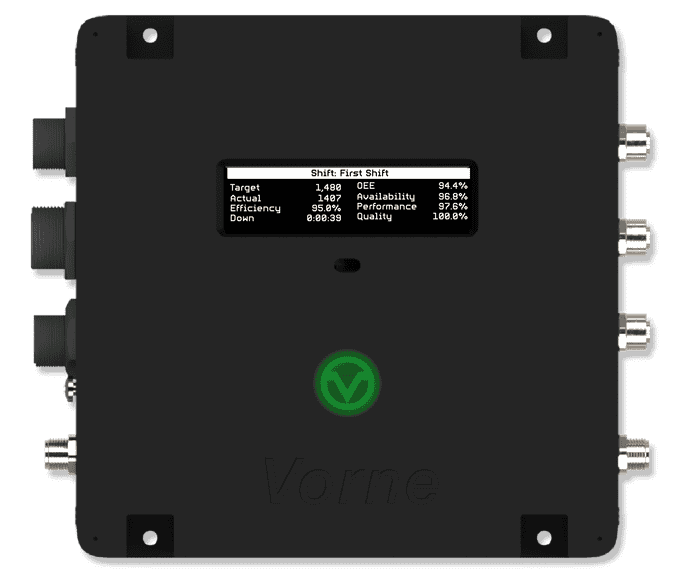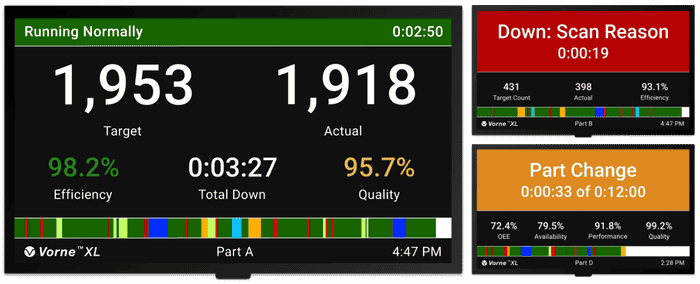Andon Systems

What Is an Andon System?
An Andon System is a lean manufacturing tool built around the same three core elements as Andons - signal, alert, and resolve. Andon Systems stay true to their Andon counterparts by working through these three core elements:
- Signals are enhanced by sensor data.
- Alerts are enhanced by a scoreboard, which provides information that goes beyond the typical indicator lights of the traditional Andon.
- Resolve is enhanced by additional reporting and analytics.
In a world of Industry 4.0, digital twins, and digital manufacturing, are Andons still relevant? Yes!
The core purpose of Andons - operators and supervisors working together to resolve the root cause of problems as they occur - is still very relevant.

A Digital Andon System goes one step further by integrating an IoT device, which also functions as an enabling technology for digital manufacturing. It includes the following elements:
- Sensors
- IoT Device
- Scoreboard
- Alert Services
- Reporting and Analytics

How Does a Digital Andon System Work?
How are the elements of a Digital Andon System integrated? Through the IoT device.
The IoT device functions as the hub of the system, serving as an Andon monitoring system:
- Sensors feed the IoT device data, which it processes to monitor production in real time. From an Andon perspective, the most important sensor is a cycle sensor at the constraint.
- The scoreboard is an Andon display driven by the IoT device to provide real-time information to plant floor operators. It shows Andon status, alert escalations, contextual information, problem notifications, and a real-time target that enables operators to know whether they are winning the shift.
The IoT device can also serve as an edge computing node, in which case it communicates curated information to a cloud platform. Either the IoT device or the cloud platform can use Andon System software to generate digital alerts (e.g., email and text notifications), as well as real-time reporting and analytics that can be helpful when resolving issues.
Operators are an essential part of the Digital Andon System. They serve as the primary observers and leverage technology to respond even more effectively to emerging problems.

Components of Digital Andon Systems
Let’s take a look at each of the elements of the Digital Andon System in more detail.
IoT Device
The IoT device is the foundation of the Digital Andon System. It’s also what enables you to access digital manufacturing features as part of the solution.
Most manufacturing plants have a significant amount of legacy equipment for which it is challenging to apply digital manufacturing techniques and tools. However, a very effective approach is to place an IoT device at each line that is designed for exactly this type of application. In other words, the IoT device is an off-the-shelf device that already has the needed functionality.
The IoT device acts as a “digital hub,” connecting sensors, a scoreboard, and optionally, a cloud platform. It can also store real-time and historical production data and distribute that information to clients as needed.

When connected to a cloud platform, the IoT device functions as an edge computing node. Edge computing nodes process data at the edge of your network, as close to the originating source of the data as possible (in this case the manufacturing line), before securely transmitting it outside of your network. This network architecture greatly reduces the amount of network traffic (by several orders of magnitude) and is also significantly more robust in the face of adverse events like network outages.
We recommend a cycle sensor (Andon signal) and a scoreboard (Andon alert) as the minimum starting point for a Digital Andon System. The preferred implementation is three sensors, as we describe in the next section.
Sensors
Sensors provide the “signal” element of the Digital Andon System. They connect to the IoT device, which automatically “pulls the Andon cord" to signal when there is a problem.
The most important sensor for a Digital Andon System is the cycle sensor. The cycle sensor monitors cycles at the constraint of your production line and automatically detects abnormalities such as slow cycles, small stops, and down events.
However, with three sensors connected to the IoT device you can generate 100+ manufacturing metrics including OEE, TEEP, and Six Big Losses. The three sensors are:
- In Count sensor at the start of your process
- Cycle sensor at the constraint of your process
- Out Count sensor (good or reject) at the end of your process
Operators still have a significant role to play as observers, but with a Digital Andon System their observations are supplemented by real-time data directly from the manufacturing process. Sensors and operators work together to enhance the Andon signal element and promote data-driven decisions.
Scoreboard
The scoreboard provides the “alert” element of the Digital Andon System. It can be driven directly by the IoT device to deliver robust real-time plant floor intelligence to operators.
As an Andon display, the scoreboard should at minimum indicate the following information:
- Line is running normally (green)
- Line is running with issues (yellow)
- Line is down (red)
As an Andon display system, the scoreboard can provide additional insights to operators. Here are a few examples:
- Escalate status visually for key events, such as long down events, to convey urgency
- Provide contextual information such as downtime for down events, target time for changeovers, etc.
- Provide real-time notifications for excessive slow cycles, small stops, quality issues, etc.
- Use operable takt time to drive a target count and enable operators to win the shift

Keep scoreboard screens simple to ensure you are supporting operators with focused, curated information rather than overwhelming them with details they don’t need. We can’t stress this enough!
Andon Software: From Alerts to Analytics
A Digital Andon System combines physical elements with software that enhances alerts and provides deeper insights.
Andon Software for Alerts
Traditional Andons use Andon lights as alert mechanisms. A Digital Andon System supplements this with push notifications such as texts and emails.
Push notifications can be sent directly from the IoT device or from a connected cloud application. The cloud application is often a better choice for push notifications because of centralized management.
Another useful feature of push notifications is automatic escalation. As an adverse event lengthens - so does the pool of people that should be informed and involved in a fix.
Andon Software for Analytics and Reporting
A Digital Andon System can provide two types of Andon-related analytics and reporting:
- Virtual Andon boards
- Context Analytics
Virtual Andon boards provide an enhanced "Andon" view that is still clearly in the spirit of the traditional Andon. As such, it should be simple, impactful, and clear, making it easy to see where attention is needed on the plant floor.
Context analytics provides information about the time leading to the most recent event. For example, a top losses report summarizes sources of lost production time. In this case, slow cycles have been by far the most significant problem.
As another example, a chronogram visually shows time leading to the most recent event using the same colors as a traditional Andon.
Analytics and reporting should echo Andons with simple, consistent, and instantaneous communication:
- Simplicity comes from focusing on a few key pieces of critical information.
- Consistency comes from applying visual cues in a standardized way (e.g., green is normal, yellow is slightly deviating, and red requires immediate attention).
- Instantaneous comes from showing data in real time.
What Are the Benefits of an Andon System?
Andon systems have a number of unique benefits:
- Enrich the concept of an Andon indicator by combining the simplicity of Andon lights and colors with the expressiveness of a plant floor scoreboard.
- Collect detailed sensor data to provide a holistic view of the production process and make that data available when conducting a root cause analysis.
- Assist operators by providing them with automatically detected information in real time, such as an increase in the number of slow cycles, which provides context and makes it easier to recognize emergent problems.
- Motivate operators by shifting how they spend their time from problem detection to problem resolution.
- Automatically call attention to a larger range of issues surrounding the manufacturing process so operators can focus on improvement actions.
- Automatically escalate alerts so the right people are informed at the right time.
- Bring meaning and value to a traditional lean concept in the world of Industry 4.0.







